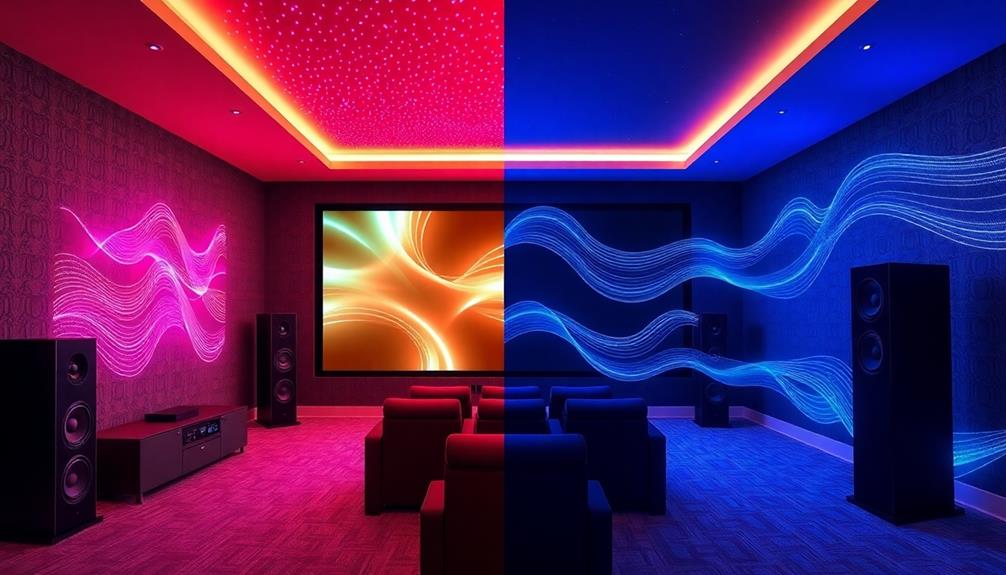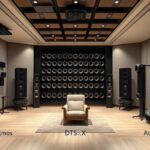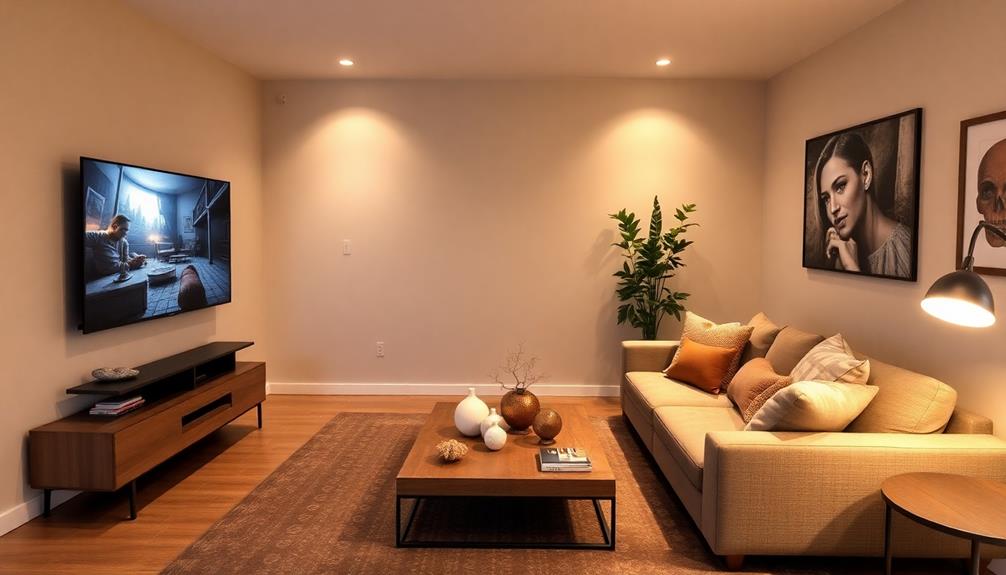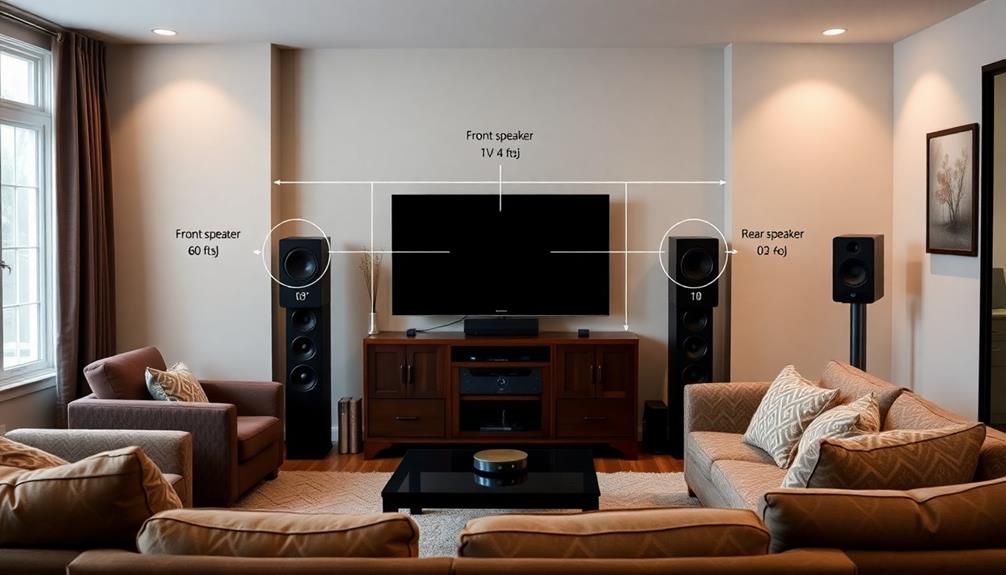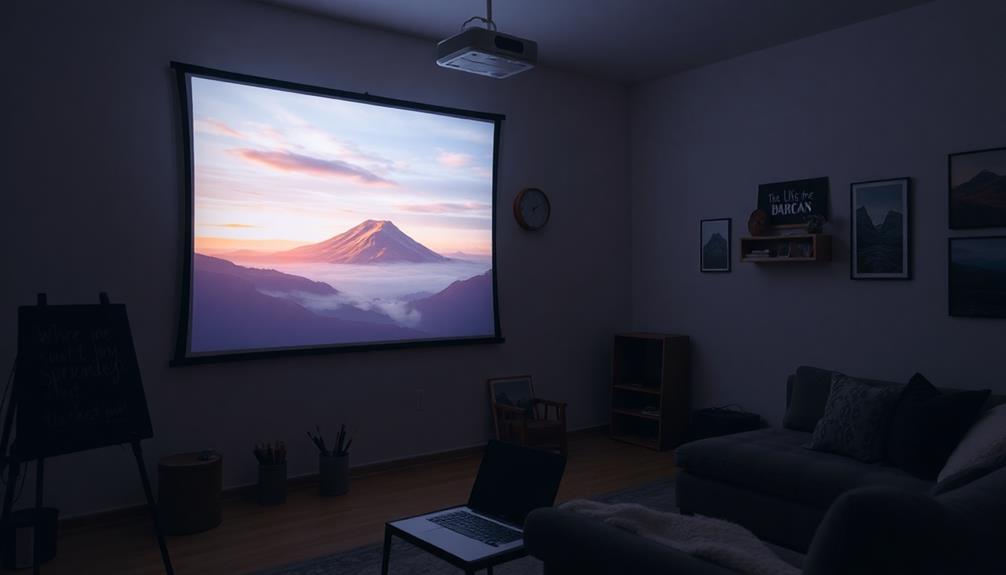When it comes to 3D audio formats, Dolby Atmos and DTS:X both offer immersive listening experiences, but they differ in key ways. Dolby Atmos supports up to 128 sound objects and requires height channels for a true overhead effect, making it widely available on streaming platforms like Disney+. In contrast, DTS:X allows for up to 32 channels without fixed speaker layouts, offering flexibility in setup, particularly for Blu-ray users. Your choice may depend on your audio setup and content availability. Explore the nuances between these formats to find the best fit for your home entertainment system.
Key Takeaways
- Dolby Atmos supports up to 128 sound objects and requires height channels for immersive overhead effects, enhancing audio experiences.
- DTS:X offers flexible configurations with up to 32 channels and does not require a fixed speaker layout, allowing for customization.
- Dolby Atmos is widely available on streaming platforms like Disney+ and Amazon Prime, making it more accessible than DTS:X, which is primarily found on Blu-ray.
- Both formats require compatible AV receivers, but Dolby Atmos benefits from a proprietary mapping system for accurate sound placement based on speaker layout.
- Consumer interest in immersive audio experiences drives the adoption of both formats, with Dolby Atmos currently dominating the market due to its extensive content availability.
Overview of Audio Formats
When it comes to audio formats, understanding the differences can greatly enhance your listening experience. Two of the most popular formats today are Dolby Atmos and DTS:X, both of which utilize object-based surround sound technology. This means they create a more immersive experience by allowing sounds to move freely within a three-dimensional space, rather than being tied to specific channels.
Dolby Atmos supports up to 128 simultaneous sound objects and requires compatible receivers with height channels for overhead sound effects. This feature makes the audio experience feel more lifelike, especially in movies.
On the other hand, DTS:X offers flexibility with its open-source design, accommodating up to 32 channels without needing a fixed speaker layout. This adaptability means you can enjoy immersive sound experiences even in less traditional setups.
While both formats deliver exceptional audio quality, content availability differs markedly. Dolby Atmos is widely available on numerous streaming platforms like Disney+ and Amazon Prime, whereas DTS:X is mostly found on Blu-ray discs, limiting its accessibility.
Modern receivers typically support both formats, allowing you to tailor your audio experience to your preferences and setup.
Key Features of Dolby Atmos
Experiencing Dolby Atmos transforms how you perceive sound, making it a standout in the domain of audio formats. This innovative technology utilizes an object-based audio format, which allows sounds to move freely in three-dimensional space.
You'll enjoy an immersive listening experience like no other as audio objects surround you, creating a rich soundscape that enhances movies, music, and games.
To fully harness Dolby Atmos, you'll need height speakers in your setup. The minimum configuration is 5.1.2, but for ideal sound placement, a 7.1.4 layout is recommended. This arrangement supports up to 128 simultaneous audio objects and provides 64 discrete sound locations, further elevating the realism of the audio experience.
Dolby Atmos has been widely adopted across various devices, including soundbars, smartphones, and smart TVs. Major streaming platforms like Disney+ and Amazon Prime support this format, ensuring you can access high-quality audio content easily.
Additionally, Dolby Atmos incorporates a proprietary mapping system that adjusts audio based on your specific speaker layout, guaranteeing sound accuracy and depth tailored to your environment. With this technology, you'll truly feel immersed in every moment.
Key Features of DTS:X
DTS:X revolutionizes your audio experience with its flexible object-based format, letting you customize your speaker setup to fit your space perfectly. This means you're not tied down to a fixed layout; instead, you can choose the arrangement that works best for you.
| Feature | Description |
|---|---|
| Object-Based Audio | Allows placement of sound objects in a 3D space. |
| Flexible Speaker Configurations | Supports up to 32 audio channels. |
| Calibration Process | Uses pink noise for dynamic adjustments. |
| Compatibility | Works with multiple playback systems. |
| High Audio Fidelity | Delivers exceptional sound quality. |
With DTS:X, you can create a truly immersive audio experience without the necessity of height speakers, although they're recommended for ideal effects. This adaptability makes it easier for you to enjoy high audio fidelity in various environments. Primarily available on physical media like Blu-ray discs, DTS:X might be less accessible than other formats, but its quality and flexibility set it apart. Embrace the power of DTS:X and transform how you listen to your favorite content!
Setup Requirements for Both Formats
Setting up your audio system for immersive formats like Dolby Atmos and DTS:X can greatly enhance your listening experience.
For Dolby Atmos, you'll need a minimum setup of 5.1.2, which includes two height channels for that overhead sound effect. If you want peak performance, consider a 7.1.4 layout. This setup requires an AV receiver that can decode Dolby Atmos streams, and using Atmos-enabled or in-ceiling speakers is highly recommended to accurately reproduce those overhead effects.
On the other hand, DTS:X offers more flexibility with its setup requirements. You can use standard speaker arrangements without dedicated height speakers, although incorporating them will elevate your experience.
Like Dolby Atmos, you'll need a compatible AV receiver, typically one that supports seven or more channels.
If you're looking for a compact solution, wireless sound bars designed for either format often utilize fewer than five channels and may include upward-firing speakers to simulate height effects.
Ultimately, the choice between Dolby Atmos and DTS:X will depend on your specific setup and personal preferences.
Content Availability Comparison
In recent years, the disparity in content availability between Dolby Atmos and DTS:X has become increasingly apparent.
Dolby Atmos has made significant strides in accessibility, with a wide range of content available on popular streaming services like Disney+ and Amazon Prime. This extensive library gives you plenty of options for enjoying immersive audio experiences in your home.
On the other hand, DTS:X content is primarily limited to Blu-ray discs. While these discs can deliver excellent sound quality, the reliance on physical media restricts the availability of DTS:X compared to the broader selection of Dolby Atmos offerings.
If you prefer Blu-ray, you'll want a compatible player that supports both formats to maximize your audio experience.
The increased availability of Dolby Atmos has influenced consumer choices, making it the more dominant format regarding media options.
However, if you're a fan of physical media, you can still access DTS:X through Blu-ray, provided you have the right equipment.
Ultimately, your choice may hinge on the platforms and formats you prefer for your entertainment needs.
Speaker Configurations Explained
How do speaker configurations impact your immersive audio experience? In the world of 3D audio formats like Dolby Atmos and DTS:X, the arrangement of your speakers plays an essential role.
Dolby Atmos typically starts with a 5.1.2 setup, featuring five surround speakers, one subwoofer, and two height channels for overhead effects. For a more expansive experience, a 7.1.4 configuration adds four height speakers, enhancing immersion.
On the other hand, DTS:X offers greater flexibility, allowing you to customize your layout with up to 32 speakers, although it doesn't require height channels. This means you can tailor your setup based on your space and preferences.
The height channels in both formats are crucial for creating a sense of overhead immersion, making sound feel like it's coming from above.
When you see configurations like 9.1.2 or 7.1.6, they reflect advanced arrangements that incorporate additional height and surround speakers, giving you a broader soundstage and deeper audio effects.
Streaming and Connectivity Needs
To fully enjoy the immersive experience of 3D audio formats like Dolby Atmos and DTS:X, you'll need to confirm your streaming setup meets specific connectivity requirements. For Dolby Atmos, verify both your streaming device and receiver support eARC (Enhanced Audio Return Channel). This feature allows high-quality audio transmission, vital for a superior experience.
Using ultra high-speed HDMI 2.1 cables is also recommended, as they can handle the increased bandwidth needed for these immersive audio formats. While platforms like Disney+ and Amazon Prime offer a range of Dolby Atmos content, DTS:X is primarily found on Blu-ray discs, so keep that in mind when choosing your content.
Here's a quick overview of the key requirements:
| Requirement | Dolby Atmos | DTS:X |
|---|---|---|
| Streaming Platforms | Disney+, Amazon Prime | Primarily Blu-ray |
| Audio Return Channel | Requires eARC | May not require eARC |
| Recommended Cable | HDMI 2.1 | HDMI 2.0 or higher |
| Compatible Receiver | Modern receivers (7+ channels) | Blu-ray player support needed |
Meeting these requirements will enhance your 3D audio streaming experience considerably.
Recommendations for Home Systems
When setting up your home audio system, choosing the right receiver is essential for enjoying 3D audio formats.
You'll want to take into account recommended speaker configurations and how compatible your setup is with streaming content.
Choosing the Right Receiver
Selecting the perfect receiver for your home audio system can greatly enhance your immersive experience with formats like Dolby Atmos and DTS:X. To make the right choice, consider these essential factors:
- Configuration Support: Verify your AV receiver supports the necessary configurations. Dolby Atmos typically requires at least a 5.1.2 setup, while DTS:X allows for more flexibility in layouts.
- eARC and HDMI 2.1: Look for receivers with enhanced Audio Return Channel (eARC) support for seamless audio transmission and HDMI 2.1 ports for peak performance, especially when streaming Dolby Atmos content.
- Compatibility and Features: Research receivers that integrate well with your existing speaker setup.
For advanced immersive sound, consider models like the Onkyo TX-RZ50, which supports multiple height channels, priced at $999.00.
Popular options like the Sony STR-DH590 and Yamaha RX-V385, both rated 4.5 stars and priced around $348.00 and $349.95 respectively, are excellent choices for enhancing your surround sound technologies.
Recommended Speaker Configurations
Creating an ideal audio experience in your home relies heavily on the right speaker configuration. For Dolby Atmos, a minimum recommended speaker configuration is 5.1.2. This setup includes five standard channels, one subwoofer, and two height speakers to deliver those stunning overhead sound effects.
If you want an even more immersive experience, consider the reference layout of 7.1.4, which features seven standard channels and four height channels.
On the other hand, DTS:X offers greater flexibility in your speaker setup. You can start with a basic 5.1 configuration and expand it to 11.1 or more channels based on your room size and personal preferences.
While height speakers are essential for Dolby Atmos setups, DTS:X can work effectively without them. However, adding height speakers will enhance your overall immersive experience.
If you're looking for a compact solution, many modern soundbars, like the JBL soundbar with four upward-firing speakers, can achieve a 5.1.4 Dolby Atmos configuration without the hassle of extensive wiring.
This way, you can enjoy high-quality audio without compromising on space or aesthetics.
Streaming Content Compatibility
To enjoy the full benefits of 3D audio formats like Dolby Atmos and DTS:X, your streaming setup must be compatible with these technologies.
Here are three vital steps to guarantee your system can handle immersive audio:
- Check Your Devices: Make sure both your receiver and source device support eARC (Enhanced Audio Return Channel) and are equipped with HDMI 2.1 cables. This is essential for peak performance and the high bandwidth required for Dolby Atmos.
- Explore Streaming Platforms: Popular services like Disney+ and Amazon Prime offer a vast library of Dolby Atmos content. However, if you're looking for DTS:X, you'll primarily find it on Blu-ray discs.
- Upgrade If Necessary: If you're using physical media, invest in a Blu-ray player that can decode both Dolby Atmos and DTS:X. This guarantees compatibility with various formats and enhances your home theater experience.
Market Trends and Adoption
In recent years, the adoption of 3D audio formats has surged, driven by advancements in technology and changing consumer preferences.
Dolby Atmos stands out as the dominant immersive audio format, widely adopted across cinemas, streaming services, and consumer devices. This extensive media support has fueled its popularity.
On the other hand, DTS:X is gaining traction, particularly due to its compatibility with legacy content and flexible sound mapping, appealing to a broader audience.
As streaming services increasingly incorporate immersive audio formats like Dolby Atmos, you'll find more options for enjoying high-quality sound experiences.
This growing market demand for 3D audio is pushing both consumers and content creators to embrace these formats.
While Auro-3D struggles with visibility and market penetration, and IMAX Enhanced holds a less mainstream presence, Dolby Atmos and DTS:X continue to lead the charge in immersive audio.
Ultimately, as you explore your options for home entertainment, it's clear that the adoption of these audio formats is reshaping how you experience sound, making everything from movies to music feel more engaging and immersive than ever before.
Future of 3D Audio Formats
As you look ahead, it's clear that emerging technologies and standards will shape the landscape of 3D audio formats.
With market adoption trends leaning towards immersive experiences, you'll find content availability expanding to meet your demands.
Innovations in audio technology will guarantee that enjoying high-quality sound becomes easier and more accessible for everyone.
Emerging Technologies and Standards
What innovations are shaping the future of 3D audio formats? As you explore the world of immersive experiences, several emerging technologies stand out, enhancing how you'll enjoy sound:
- Advanced Object-Based Sound Systems: Formats like Dolby Atmos and DTS:X are revolutionizing audio by allowing sound to be treated as individual objects, providing a more dynamic listening experience.
- Open-Source Platforms: DTS:X's MDA is paving the way for broader compatibility, ensuring you can set up your audio system flexibly, regardless of your speaker configuration.
- Wireless Audio Transmission: Innovations in this area are making it easier than ever to integrate immersive sound formats into your home without the hassle of complicated wiring.
Additionally, advancements in audio codecs, such as MPEG-H, promise to enhance your control over sound elements, especially in live broadcasts and streaming applications.
With the rise of streaming services driving demand for formats like Dolby Atmos, the future looks bright for DTS:X as it expands its presence in physical media.
These developments will surely elevate your listening experience to new heights.
Market Adoption Trends
The landscape of 3D audio formats is rapidly evolving, with Dolby Atmos leading the charge as the preferred choice for most consumers. Its extensive support across commercial cinemas, streaming services, and consumer devices has fueled its widespread adoption. Meanwhile, DTS:X is gaining traction due to its flexibility and compatibility with legacy content, appealing to users who want easy integration in their audio setups.
Here's a quick comparison of market penetration and adoption trends:
| Format | Market Penetration |
|---|---|
| Dolby Atmos | High |
| DTS:X | Growing |
| Auro-3D | Limited |
| Streaming Services | Increasingly adopting |
| Consumer Devices | Expanding support |
Emerging streaming services are incorporating immersive sound formats, enhancing consumer options and driving interest in both Dolby Atmos and DTS:X capabilities. The growing demand for high-quality audio experiences suggests a bright future for both formats as consumers seek to replicate cinema-like sound in their homes. With more content and devices supporting these formats, you can expect immersive sound to become a staple in your entertainment experience.
Content Availability Expansion
With the growing popularity of 3D audio formats, content availability is expanding considerably, catering to the increasing demand for immersive sound experiences.
You'll find that both Dolby Atmos and DTS:X are becoming more accessible across various platforms. Here are three key trends to watch:
- Streaming Platforms: Dolby Atmos is rapidly integrating into major streaming services like Disney+ and Amazon Prime, offering a wide range of films and series in immersive audio formats.
- Physical Media: While DTS:X primarily thrives on Blu-ray discs, it's gaining ground. More home media releases are now including DTS:X audio tracks, enhancing your viewing experience.
- Emerging Technologies: Advancements in HDMI standards, particularly eARC, are making it easier for content creators to stream high-bitrate audio formats, further boosting content availability.
As immersive audio becomes standard, expect even greater compatibility across consumer electronics, leading to a broader selection of content available in both Dolby Atmos and DTS:X formats.
With this expansion, you're sure to enjoy a richer, more engaging audio experience in your home entertainment setup.
Frequently Asked Questions
What Is the Best Format for 3D Audio?
When considering the best format for 3D audio, you'll want to weigh immersive experiences against flexibility. Dolby Atmos excels in cinematic sound, while DTS:X offers adaptability for various setups. Your personal preference will ultimately guide your choice.
What Is the Difference Between 3D Sound and Dolby Atmos?
Imagine being in a concert, feeling music swirl around you. 3D sound creates that sensation, while Dolby Atmos enhances it by placing sounds precisely in a three-dimensional space, making your experience even more immersive and lifelike.
What Is the Difference Between Dolby Atmos and Immersive Audio?
You'll find Dolby Atmos is a specific format designed for immersive audio experiences, while immersive audio encompasses various technologies, including Atmos. Each aims to enhance sound, but their features and implementations differ considerably.
What Is the Difference Between Atmos 3D and IMAX 3D?
Did you know that over 200 films have been released in IMAX 3D? While both formats offer immersive experiences, Atmos 3D emphasizes precise audio placement, whereas IMAX 3D combines visuals and tailored sound for unique cinematic moments.
Conclusion
As you explore the world of 3D audio, it's clear that both Dolby Atmos and DTS:X offer unique advantages. Some believe that Dolby Atmos is leading the charge due to its widespread adoption, but DTS:X's flexibility and adaptability can't be overlooked. Ultimately, your choice might depend on your specific home setup and content preferences. The truth is, both formats enhance your audio experience in different ways, and your ears will be the best judge of which one you prefer.
